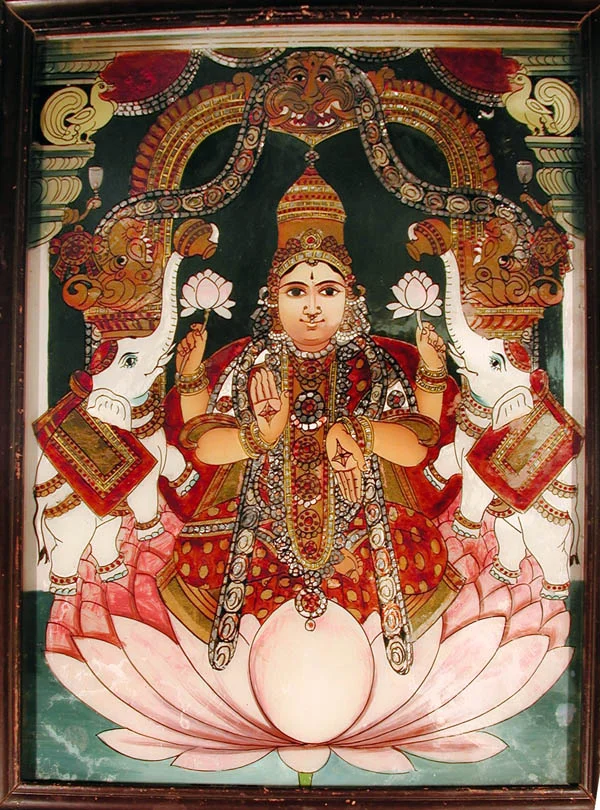हिरण्यवर्णां हरिणीं सुवर्णरजतस्रजाम् । चन्द्रां हिरण्मयीं लक्ष्मीं जातवेदो म आवह ॥१॥
तां म आवह जातवेदो लक्ष्मीमनपगामिनीम् । यस्यां हिरण्यं विन्देयं गामश्वं पुरुषानहम् ॥२॥
It is that time of the year again, when we adore Devi in all her manifestations; from the benevolent to the terrible; she cleanses the world of evil and fills it with her blessings.
It is an appropriate time to reflect on ‘stri’, on ‘shakti’; the divine as well as the human feminine. Through a consideration of the divine we can also understand the conception of the feminine principle in Hindu philosophy and theology.
This has numerous aspects and is the study of many lifetimes. Over thousands of years there have been many, many attempts by rishis and devotees alike to capture the immanence and transcendence of Devi.
So, why start with the Sri Suktam?
This is, arguably, the first literary manifestation of Indic thinking around the feminine principle. The composition of 16 shlokas appears in the khilanis of the Baskala Shakha of the Rigveda. There are also 11 supplementary shlokas (which are not strictly part of the Sri Suktam). It can be inferred that this is a source for many of the future compositions, thinking and philosophy around the feminine in later times as the Shakta tradition manifested and established itself.
Let us take a look at the Sukta itself of which the first two shlokas are placed at the beginning of this article.
A beautiful rendition of Sri Suktam by Pandit Jasraj and Kumari Shweta Pandit.
Source: Youtube
The cadences of this suktam are mesmerising, listening to it makes the image of Devi rise up before one; effulgent, glowing, the golden one. Green and moist like the earth mother, hot and blazing like the sun, harbinger of happiness, giver of all that mortals can wish for. Riches, prosperity, sons and grandsons, cows, horses, elephants, servants, long lives; there is nothing in the three worlds which is not in the power of Devi.
As Bhudevi, she is the kaarana or cause of the fertility of the earth and creation, vanaspati in all of its forms.
All that is auspicious, “Laxmi”, can be received with the blessings of Sri; she will come and reside with the supplicant banishing “Alaxmi” forever. The Alaxmis of body and mind, hunger and thirst, wretchedness and degeneration can be banished forever.
She herself is praised as the one who manifests as Agni, Vayu, Surya, Vasu, Indra, Brihaspati, Varun and the Ashwins. In other words she is Brahman, Kshetraj, the divine principle of creation.
The purpose here is not a description or translation of the shlokas. I would invite the readers to listen to the chanting and understand the literal meaning, of which a synopsis has been given above, for themselves.
What understanding can we gain from the Sri Suktam on the subject of Stri and Shakti in Indic/Hindu thought?
The first overwhelming impression is of immanent merciless power and transcendent beauty. The metaphors and words used are those relating to both war, conflict and victory as well as purveyors of domestic riches and prosperity. She wields the danda of power and is the also the dispenser of justice in the three worlds. Success in trade and commerce is hers to gift. Bliss or aanand is hers to give.
Devi herself has a blazing yet soft lustre and radiance, a lotus herself and living in one with all the resultant symbolism in Indic thought; purity, beauty, fertility, life, growth, spirituality; the universe in a flower.
The four purusharthas of Dharma, Artha, Kama and Moksha can be attained with the grace of Sri. Like the Bhagwad Geeta after it the Suktam acts as a shield against krodh, lobh, matsarya; anger, greed, jealousy, bad intentions and helps mortal beings attain equilibrium in their lives on earth.
A detailed study of the shlokas brings out the fact that there are references in them to all aspects of life; food, dress, war, grihasti, desires, fears, enjoyment, they can be understood as a blueprint for a life of earthly aanand.
This, as noted above, is from one of the earliest portions of the Rigveda. Consequently, when we read many of the Puranas of later times or examine the worship of different devis and devatas they can be referenced back to these shlokas. I will give a few examples here.
The most important of course is the Goddess Laxmi who is worshipped not only in India by Hindus but in many other countries in the Indic sphere of influence especially in South East Asia, China and Japan, in different forms and names, of course.
Painting of Shri Laxmi in San Diego Museum, accredited to the Court of Thanjavur.
Source: San Diego Museum Collection, Flickr
An instance of a Purana reference is the story of the birth of Shri Laxmi’s son, Kardama, which can be read in the Bhagwat Purana. Also, the shlokas of this suktam have influenced the stutis in other Puranas such as the Vishnu Purana. Another interesting example is the mention of Manibhadra , the treasurer of Lord Kubera who was in later, post Vedic times, the God of merchants and traders who sailed across the seas.
As a historian and student of the iconography of vigrahas and moortis, I find it most significant that the basic elements of the Shri Laxmi’s representation, standing on a lotus, surrounded by lotuses and with elephants pouring libations of water on her with their trunks are described exactly like this in the Shri Suktam. The earliest archaeological remains of Devi temples of the 2nd century BCE exhibit the same iconography to say nothing of the paintings of Raja Ravi Verma. The continuity is astounding and humbling. We are the inheritors of a millennia of thought and conception of the feminine principle.
In conclusion, what thoughts does this brief introduction to the Sri Suktam leave us with?
Shri is the cause of creation, the three worlds are her manifestation and she is the giver of boons to her children, the mortals on this earth.
The Shakta tradition definitely has its seeds in this very sukta. The Devi Mahatamya, Devi Upanishad and all the other deeply female centred traditions focused in Eastern India in particular can be traced ideologically speaking, to this Suktam.
And what of the earthly realm so that we may connect this to our own experiences?
Creation is seen in terms of the earth mother, the female body is the manifestation of the divine.
Not for nothing is Bharat, or ancient Jambudweepa seen as connected by different parts of the body of Sati. This is not a Shiva centred metaphor for Prithvi but a female centric one.
The ideas emerging from the Shri Suktam where Stri is not only the worshipper but the worshipped; not only the seeker of boons but also the granter; where stri is the parabrahma behind creation provides a fruitful entry to the exploration of femininity in Indic culture.
It is not the end but the beginning of the journey.
about the Author
Sumedha Verma Ojha
Sumedha Verma Ojha is an author, columnist and speaker. She was born in Patna and educated in Delhi, graduating in Economics (Lady Sriram College) and post-graduating in Sociology (Delhi School of Economics). After 2 decades in the Indian Revenue Service, she switched careers to research and write a book set in the Mauryan period based on the Arthashastraof Chanakya. Urnabhih then expanded into a book series on the Mauryan Empire and its successors.
Sumedha now works in the area of translating and explaining the epics and bringing ancient Sanskrit/Prakrit literature to the world as also in the area of a gendered analysis of ancient India. Through her talks across the world she tries to bring the influence, beauty and soft power of Ancient India alive again. She lives with her husband near Geneva and has two children both studying in the US.
Besides Urnabhih, published by Roli Books in 2014, Sumedha Verma Ojha authored The Mewar Ramayana (Awarded by the Federation of Indian Publishers), published in 2016 by the same publisher. Her forthcoming books include Urnabhih Book 2 and The ‘Modern’ Women of Ancient India (2017). Urnabhih is all set to be released as a TV series soon.



